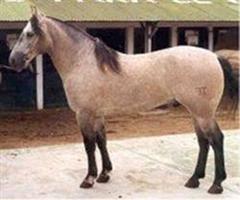Criollo (Uruguay)
The crioulo (in Portuguese)
Tue, 19th November, 2024 - 2:39 am GMT
Sponsor Ads:

Alternative Name
The crioulo (in Portuguese)Basic Info
Height : 14 - 15 hh. Colours : Usually dun with dark dorsal stripe, but also can be chestnut, bay, roan, grey, black. Identifying Features : Medium head, convex face, muscular neck, short deep body, strong legs.
Health
N/AHabitat
N/ABehavior
In 1540, Indian hostility forced the Spaniards to abandon Buenos Aires and between 12-45 surviving horses were set loose. When Buenos Aires was resettled in 1580 it is estimated that the feral horse population numbered around 12,000. Since it largely reproduced in the wild the crioulo developed into an extremely hardy horse that was able to survive the extreme heat and cold, subsist with little water, and live off the dry grasses of the area. Settlers later came and started capturing horses for riding and for use as pack animals. The Native Americans had already been doing that many years before. Throughout the 19th century a large proportion of the horses were crossed with imported European Throughbred, coach and draft horse stallions and a larger, coarser, long striding multi-purpose cart and saddle horse resulted. However, the crossbreeding nearly ruined the native Spanish horse type. In 1918, the Argentine breeders decided to create a purebred crioulos registry. The breeder's association was formed in 1923. Much infighting occurred between the bands of Emilio Solanet and Enrique Crotto as the first promoted the Asian type crioulo and the latter the taller African type with a coarse convex head, fallen croup and thinner mane and tail. It was not until 1934 that Dr. Solanet was able to firmly take control of the breeders association and set a new goal for the breed as a shorter more compact stock horse which emulated the Chilean Horse breed he so much admired. In 1938, 70% of the registered crioulos were culled because they did not possess the phenotype aspired by Dr. Solanet and his followers. The new breed standard which he had written in 1928 was finally made available to the public now that he was assured the breeders were more united in their breed objectives. It would not be until 1957 that the registry was closed for Argentine native breds but the registry has remained open for the Chilean Horse breed that has been so influential in giving shape to the crioulo as a better stock horse. Nevertheless, the breed maintains its own identity in a taller, leggier and squarer body conformation with a more angular hock that gives it the long stride it requires to cover the great distances in the flat Argentine plains (known as "pampas"). The modern crioulo head prefers with a straight facial profile and a shorter muzzle and longer ears than is typical in the Chilean Horse breed. The breeders implemented rigorous endurance tests to help evaluate horses for breeding. In these events known as "La Marcha" the horses ride over a 750 km (466 mi) course to be completed in a 75-hour split in 14 days. No supplemental feed is allowed: the horses may only eat the grass at the side of the road. At the end of the day, a veterinarian checks the horses. The horses are required to carry heavy loads of 245 lb (110 kg) on their backs.Origin
AmericaHistory
The crioulo (in Portuguese) or "criollo" (in Spanish) that is the native horse of Argentina (1918), Uruguay (1923), Brazil (1932) and Paraguay, may have the best endurance of any horse breed in the world next to the Arabian. In fact, due to its low basal metabolism it may be a better long distance horse than the Arabian in prolonged races over a week in duration with no supplemental feed. The breed is most popular in its home country, and is known for its hardiness and stamina. The word criollo originally referred to human and animal beings of purebred Spanish ancestry that were born in the Americas, or, in Portuguese "crioulo", to animal or slave (black person) borned in Americas. With the time the significance of the word would simply come to mean native breds of the Americas.Common Foods
grassSponsor Ads:
It doesn't much matter whom you marry, for tomorrow morning you discover that it was someone else. -- Unknown
Criollo (Uruguay)
Coded by: BGID® | ALL RIGHTS RESERVED Copyright © 2000-2024
Disclaimer | Privacy | Report Errors / Contact | Credits
















